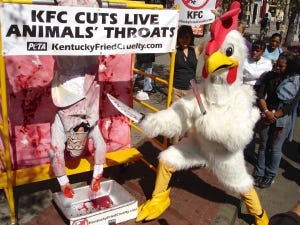The Chicken Who Killed Colonel Sanders
On a bright morning in New York not long ago, outside the KFC on Sixth Avenue, pedestrians stopped dead in their tracks. Colonel Sanders—the kindly KFC mascot, the goateed guardian of the secret recipe for finger-lickin’ fried chicken—was hanging upside-down over the sidewalk, screaming. He was being tortured to death by a seven-foot-tall chicken, which hopped about waving large knives and slashing at his torso. Blood spewed onto the sidewalk.
A young boy holding the hand of his babysitter approached, his eyes like ping-pong balls. Spectators were starting to gather, and the chicken turned to them, taunting them with a series of kung-fu gestures. This was a seriously pissed chicken.
The spectacle was courtesy of People for the Ethical Treatment of Animals (PETA). The shock factor, said Lindsay Rajt, a PETA volunteer, aimed to highlight KFC’s institutional practices of breaking chickens’ bones, snapping off their beaks, and boiling them alive without properly stunning them to reduce the pain.
“Unfortunately, the abuses we see at KFC happen across the industry,” she said. “But we target KFC because when they change, others will follow.”
When it was time for a break, the head of the chicken came off. Inside was a 24-year-old Australian named Karen Nielson. She was exhausted and panting, and someone asked her if she was OK. “It’s nothing compared to what the chickens go through,” she said.
PETA’s website features a video narrated by the actress Pamela Anderson. “You probably have heard of the Colonel’s secret recipe,” she says. “But you probably have no idea what goes into making a bucket of KFC chicken. Sadly, the main ingredient is cruelty.”
KFC’s website says the company is “committed to the humane treatment of animals.” It maintains that its parent company, Yum! Brands, does not own, raise, or transport the animals used in its meals. But the website concedes that “it is our goal to only deal with suppliers who promise to maintain our high standards and share our commitment to animal welfare.”
In the attempt to improve public relations following protests in the mid-90s over its treatment of chickens, KFC formed the Animal Welfare Advisory Council, consisting of animal-rights experts whose recommendations the company says it has followed. But PETA maintains otherwise. “Six years after KFC first promised it that it takes animal welfare seriously,” Anderson says in the video, “a PETA undercover investigator witnessed workers... slamming live animals into walls, stomping up and down on them, kicking them across the room, and tearing them apart.” The video zooms in on a KFC sign, then cuts to footage of workers hurling chickens into walls at a slaughterhouse in West Virginia. One worker is seen jumping up and down in an apparent attempt to kill a chicken.
More than 750 million chickens are slaughtered each year for KFC. (A total of nine billion are raised and killed in the United States annually.) PETA maintains that
they are treated like meat machines, not animals. They are crammed by the tens of thousands into sheds. Their throats burn as they try to breathe air filled with ammonia fumes from accumulated waste... Many chickens are still conscious as their throats are cut or when they are dumped into tanks of scalding hot water for feather removal.
The video shows chickens hanging by their feet on an automated belt that whisks them toward their fate. The birds are run through an electric stun bath that, according to PETA, often fails to render them insensible to pain. Their throats are then slit before they’re dumped into boiling water. “Some birds are still alive and conscious through the entire frightening and painful procedure, and then they are scalded alive,” Anderson says in the video.
At the protest on Sixth Avenue, not all passersby were sympathetic to the cause. “Everybody who makes chicken kills a fuckin’ chicken,” said Miranda Richards, 21.
But Muneer Richards, 30, felt differently. “Looking at this, I’ll have to reconsider” eating at KFC, she said. As she spoke, Colonel Sanders let out a dying wail. When confronted about KFC’s practices, employees inside the franchise refused to comment. One cashier, calmly staring out the window, told a colleague, “They’re killing people all over the Middle East. Why are they worried about chickens?”
When it was time to call it a day, the two activists took off their head gear and reached for water. The young man dressed as Colonel Sanders was breathing heavily, his mouth clenched in pain. “I’m sorry,” said Nielson, her head popping out of the chicken suit. “I think I hit you a few times too hard.”
The protest had lasted an hour. During that time, as Colonel Sanders met his bloody end, another two million chickens met theirs.
